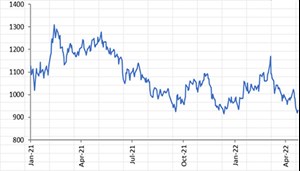Articles
Materials and processes required for a sustainable future
Editorial Comment
T. CAMPBELL, Managing Editor
Hydrogen (H2) project announcements have continued to grow over the past year. These projects are essential to reach regional and national net-zero goals by 2050. However, on the path toward 2050, 2030 will be the first milestone—progress made by this point will determine if economies are moving in the right direction and if 2050 goals are feasible.
One of the key performance indicators for fulfilling the 1.5°C scenario by 2030 is clean H2 production. According to the International Renewable Energy Agency’s (IRENA) World Energy Transitions Outlook 2022, the production of clean H2 and its derivative fuels must ramp up to 154 MMt by 2030.1
Renewable energy is required to produce H2 with zero carbon emissions (i.e., green H2). This includes wind (onshore and offshore), solar and hydropower. Hundreds of billions of dollars must be invested by the end of the decade to significantly increase wind and solar power generation capacity to fuel electrolyzers. According to H2Tech’s Market Data Book 2023, the electrolyzer market is forecast to increase by 8,000% by 2031, reaching more than 100 GW.2
However, there has been a cost increase in materials essential to manufacturing electrolyzers, such as nickel, platinum and iridium. Proton exchange membrane electrolyzers require platinum and iridium for the electrocatalyst; alkaline electrolyzers use nickel as raw material for electrodes. Platinum prices will likely be impacted by sanctions on Russia, one of the major producers of platinum (FIG. 1). Iridium prices have already significantly risen over the past 2 yr (FIG. 2).
Process and project optimization. Digital technologies provide operators an opportunity to monitor and optimize processes continuously. Manual operations leave room for human error, whether from fatigue or inexperience. In addition to safer and more effective practices, the digitalization of operations presents an opportunity to decrease electrolyzer costs.
LITERATURE CITED
1 International Renewable Energy Agency, “World Energy Transitions Outlook 2022,” online: https://www.irena.org/-/media/Files/IRENA/Agency/Publication/2022/Mar/IRENA_World_Energy_Transitions_Outlook_2022.pdf?rev=353818def8b34effa24658f475799464
2 H2Tech, “H2Tech Market Data Book 2023,” online: https://www.nxtbook.com/nxtbooks/gulfpub/h2tech_marketdata_2023/index.php#/p/Cover1/OnePage



